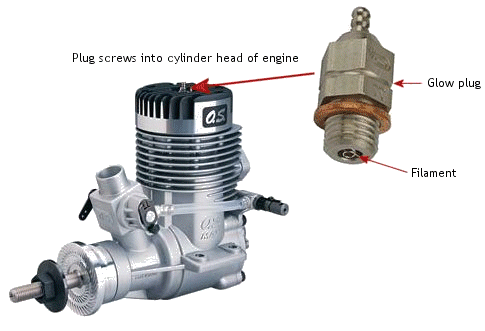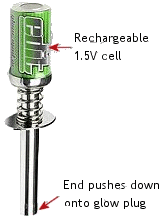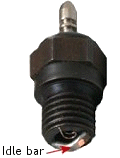
Learning a bit about glow plugs for rc airplanes and helicopters will help you make the right choice of plug for your engine, and that can make a big difference in its performance.
Of course, your engine instruction manual should make the correct recommendations for which glow plug(s) to use, and these recommendations should be your first option for plug selection. The information outlined below should be taken as a general understanding of glow plugs.
So what is a glow plug and why is it needed?…
A glow engine (also called ‘nitro’ or ‘gas’ engine) for an rc model plane, helicopter, car or boat runs on a special blend of fuel that contains oil, nitro methane and methanol.
While the oil is present to provide the necessary lubrication inside the engine, it is the nitro methane and methanol that provide the combustible mixture that keeps your glow engine running. And like any internal combustion engine, that mixture needs a source of ignition. In a real-life automobile engine, that source comes from the spark plug; in an rc model glow engine, that source comes from the glow plug.

But, whereas a spark plug produces a spark that occurs repeatedly and very rapidly, a glow plug burns continuously. It’s this continuous burn that ignites the fuel/air mixture inside the combustion chamber of the engine, and it is the extremely high temperature, from the ignition of the mixture inside the chamber, that keeps the glow plug glowing.
The part of the plug that glows red hot is called the filament – a thin coil of wire seated inside the threaded section of the plug.
Unlike an automotive spark plug that needs a constant supply of electricity from the coil to repeatedly produce a spark, a glow plug only needs an initial supply of electricity from a glow plug igniter ..

This source of power, typically 1.5V, heats the filament of the plug to glow red hot, and once the engine is running it is then the heat within the combustion chamber that keeps the filament red hot.
Using the glow plug igniter is very simple; it is placed onto the top of the plug and left there while the engine is started. Once running, the igniter can be left in place for a short time while the engine gets up to temperature, but it should never be left attached to the glow plug for too long.
Different types of glow plug
There are several types of glow plug for rc aircraft engines, and which one you use will depend on the type of engine you have eg whether it’s a plane or helicopter engine, its size, whether it’s 2 stroke or 4 stroke etc.
A fundamental difference between glow plugs is the ‘heat’ rating, where different plugs are designed to burn hotter or cooler. This greatly effects the performance of an engine, but this rating isn’t as significant for rc aircraft engines as it is for surface vehicles, where the engines experience much greater fluctuations in throttle settings and hence operating temperatures.

Another difference that you’ll see is that some glow plugs have idle bars and some do not. The idle bar is a small bar that runs across the base of the filament, its purpose is to guard the filament from getting ‘drowned’ by too wet a mixture during idle.
During longer periods of idling, the temperature inside the combustion chamber drops relatively significantly, and the plug filament will not burn as well. The fuel mixture hitting the cooled filament adds to the problem, making it cooler still. When the throttle is opened and power is needed, the engine may splutter or even cut out as a result, because the filament hasn’t the heat to ignite the fuel/air mixture properly. The idle bar stops this from happening by preventing this unwanted cooling of the filament.
For average rc flying with, say, a .46 2 stroke engine commonly found in most rc trainers or sport planes, a glow plug such as the OS#8, or the Enya#3 for helicopter engines, is a popular choice for many flyers. These represent your ‘typical’ glow plugs for rc aircraft.
But like most things in life, choosing the best plug for your engine can be a case of trial and error. For this reason it’s always best to buy a selection of plugs, so if your engine isn’t running well from one day to the next, you can try a different one.
If your glow plug engine won’t start, a broken (or breaking down) glow plug is an obvious cause, and is the first thing to check and replace if necessary. And of course, a glow plug igniter that hasn’t been charged and so can’t heat the filament enough will also be a primary cause of the engine not starting!
The way to test a glow plug is to remove it from the cylinder head and place it in the igniter – if the filament immediately glows a healthy orange color, then the plug is healthy. If there is no glow, or a weak one, try a different plug and check the voltage of your igniter.